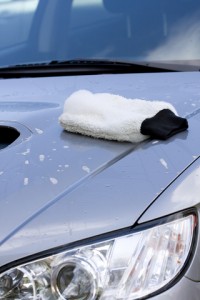How to Wash a Car Without Scratching the Paint
Car washing is the single most important step in keeping your car clean as this process takes out majority of the dirt build up on your vehicle.
Before we get started please refer to the tools required to wash your car for product suggestions.
As you use your car in your daily commute, dirt and grime accumulate and build up especially on rainy days, by washing the car regularly you take out all that dirt accumulated.
It is important that you use the right tools and technique as swirl marks will result if you fail to wash your car properly. It is not a pretty sight, more so on darker coloured cars.
The good news is that this can be prevented with careful washing and drying. Follow these simple steps the next time you wash your car.
 How often do you wash your car?
How often do you wash your car?
Washing your car weekly is recommended because dirt and contaminants can do some serious damage on the paint if they are not cleaned and the most damaging of those contaminants are bird droppings, tree saps, and dead bugs. These contain acids and chemicals that if left on for an extended period will stick to the surface of the paint and gradually eat through the clear coat that protects your car’s paint – it will be susceptible to corrosion and oxidation even rust if it eats through the base coat.
Brake dust is another contaminant you don’t want to accumulate on your car’s wheels and paint. It’s made up of metal and adhesives that could permanently stick on paint if left for an extended period, it can be difficult to remove and become unsightly.
Never wash your car under direct sunlight or if the surface is hot. Ideally wash in a covered area. A good time to wash would be early in the morning or evening when it’s nice and cool.
How to Wash a Car – Follow These Steps!
1. Start with the wheels and tires

To get started spray a good amount of wheel cleaner on the rims, tires and wheel wells, allow at least 30 secs for the cleaner to soak and loosen up dirt. Use a wheel brush to clean out dirt then rinse. Wash each of the wheels and tires one at a time and rinse them thoroughly before washing the next. Check out the video below for the different wheel brushes you can use to clean your wheels.
Just in case you run out of wheel cleaner, you can use a car shampoo as a substitute.
Don’t wash your wheels if they’re hot – you could warp your brake rotors when cool water touches the hot surface of the rotor.
2. It’s time to wash
Before washing your car, rinse thoroughly to remove dust and debris.
Pour in around a cap full of car shampoo in a bucket then add water, you can use 2-cap fills or more if the car is really dirty.
Start from the top of the vehicle then move down, not front to back. The lower panels are the dirtiest so you want to do that last so you don’t transfer dirt from the lower part to the top part of the vehicle and possibly scratching the paint.
Before using a car shampoo, please read the instructions at the back label for the proper dilution ratios to maximize each bottle you use.
Just in case you forgot please refer to the tools required to wash your car for product suggestions.
3. How do I prevent swirl marks?
The best way is to use two buckets. The first bucket will carry soapy water while the other is filled with clean water. After each pass, rinse your wash mitt in the bucket of clean water to take out contaminants then soak it in soapy water again to continue washing. A better option would be placing a grit guard insert inside your bucket of clean water to help take out dirt and grime.
Rinse your wash mitt after each pass so you don’t accumulate dirt. Rinse your vehicle often as you wash your car – especially on a hot day.
4. Remove Tar and Bugs

A better option would be using a bug and tar remover, just spray on the affected area and wait a few seconds for it to loosen up the bugs and tar, then wipe off with a microfiber towel. Don’t forget to re-apply wax after.
Dry the car first before you spray the bug and tar remover.
Don’t forget to check out Remove Tar and Bugs, for an in-depth guide in removing stubborn bugs and tar.
5. Finally rinse your car.
As a final step, rinse the car with free flowing water without the nozzle on your hose so that water will run off the surface and you have less water when you dry your car.
I’m concerned about water consumption every time I wash my car. How can I save water and still keep my car clean?
Absolutely! Check out alternative ways of washing your car using the Optimum No Rinse and Waterless Car Wash.
Whats Next?
